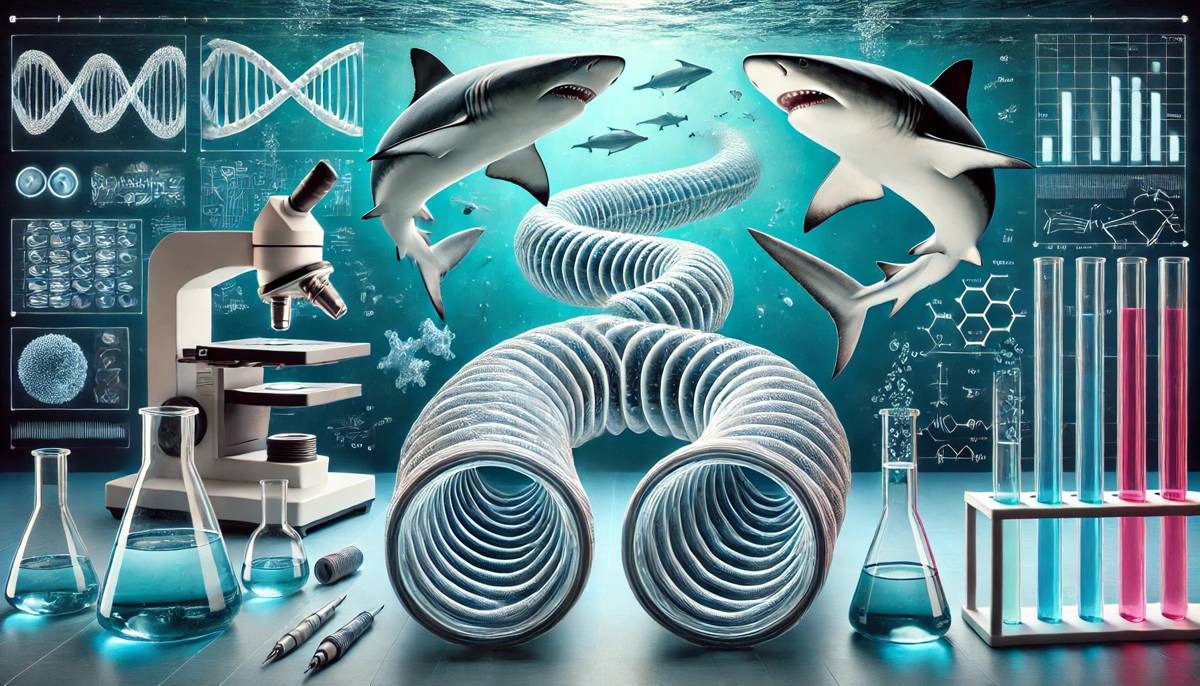Understanding Sharks is Revolutionising Fluid Dynamics
Researchers have long taken inspiration from nature when it comes to innovation. This time, it’s the shark, a predator known for its sleek design and powerful efficiency, that has inspired a breakthrough in fluid dynamics. But it’s not the shark’s speed or teeth that have scientists excited—it’s their intestines.
Researchers at the University of Washington (UW) have discovered a revolutionary way to direct fluid flow in pipes, drawing on the unique helical structure of shark intestines. This design could reshape industries ranging from engineering to medicine.
So, how did sharks become the unexpected muse for scientists and engineers? Let’s dive deeper into this fascinating research.
A Shark’s Secret Weapon
Sharks and rays, unlike humans, don’t have a simple, hollow tube for intestines. Instead, their digestive tracts are a marvel of evolution, featuring spirals that wrap around the interior passageway. It was initially thought these spirals simply increased surface area for nutrient absorption.
However, in 2021, another team of scientists hypothesised that this structure also facilitated the unidirectional flow of fluids—a process called “flow asymmetry.” This caught the attention of UW postdoctoral researcher Ido Levin, who led the new study.
Levin’s team, including chemistry professors Sarah Keller and Alshakim Nelson, wanted to investigate whether these spiral structures alone could promote one-way fluid flow without relying on mechanical aids, like valves or flaps, which are typically found in engines or human anatomy. Their findings have sparked considerable excitement.
3D-Printing Biomimetic Pipes
The research team turned to biomimicry, which involves replicating nature’s designs to solve human challenges. Using cutting-edge 3D-printing technology, they created a series of “biomimetic pipes” modelled after the spiral layout of shark intestines. By varying geometrical parameters—such as the pitch of the helix and the number of turns—they were able to fine-tune their designs.
At first, the pipes were made from rigid materials. Some prototypes showed a clear preference for unidirectional flow, meaning liquid could move freely in one direction but was restricted in the other. The team knew they were on to something.
“The first measurement of flow asymmetry was a ‘Eureka’ moment,” Levin recalls. “Until that instant, we didn’t know if our idealised structures could reproduce the flow effects seen in sharks.”
What they discovered was remarkable. By tweaking the geometrical properties of their prototypes, they managed to increase the flow asymmetry so much that their designs began to outperform the famous Tesla valve—a device invented by Nikola Tesla over a century ago that also directs fluid flow without moving parts.
“You don’t get to beat Tesla every day!” Levin noted, clearly thrilled by the achievement.
The Power of Flexible Pipes
But the team didn’t stop there. While their rigid prototypes showed great promise, they suspected that flexibility could unlock even more potential. After all, shark intestines aren’t rigid—they’re flexible. The researchers hypothesised that using deformable materials might lead to even greater flow asymmetry.
Their intuition was correct. They 3D-printed a second series of biomimetic pipes using a soft, flexible polymer—the softest material they could find that was both printable and commercially available. These flexible designs, which better mimicked the elasticity of shark intestines, outperformed rigid pipes by a significant margin, exceeding the flow efficiency of even the best Tesla valves by seven times.
“Chemists were already motivated to develop polymers that are simultaneously soft, strong, and printable,” said Nelson, an expert in polymer chemistry. “The potential use of these polymers to control flow in applications ranging from engineering to medicine strengthens that motivation.”
Of course, there’s still room for improvement. “Actual intestines are about 100 times softer than our soft material,” noted fellow researcher Naroa Sadaba. The team is optimistic that further advancements in materials science could lead to even more effective designs.
The Future of Fluid Flow
So, why does this discovery matter? Well, the ability to control fluid flow without mechanical parts opens up a world of possibilities across multiple industries. Let’s take a look at a few potential applications:
- Medical Devices: Flexible biomimetic pipes could revolutionise the design of medical equipment, such as catheters, which often require precise fluid control in delicate environments. By mimicking the natural efficiency of shark intestines, these devices could be made more reliable and longer-lasting.
- Wastewater Management: In the environmental sector, one-way flow systems could be used to improve the efficiency of wastewater treatment plants, reducing energy consumption and operational costs.
- Engineering and Construction: Whether it’s hydraulic systems or heat exchangers, the ability to ensure unidirectional flow without valves or pumps could lead to more efficient and less maintenance-intensive designs.
- Aerospace and Automotive Industries: Fluid flow control is crucial in everything from fuel systems to cooling systems. The introduction of flexible, valve-less pipes could increase the durability and reliability of these systems, making them more efficient and less prone to failure.
Nature as the Ultimate Engineer
The power of biomimicry lies in its ability to draw on billions of years of evolution. “Biomimicry is a powerful way of discovering new designs,” Keller said. “We never would have thought of the structures ourselves.” The team’s success is a testament to the value of interdisciplinary collaboration. By combining biology, chemistry, and physics, they’ve created a solution that could have wide-ranging impacts.
The research, funded by the National Science Foundation, Washington Research Foundation, and the Fulbright Foundation, is still in its early stages, but its potential is already clear. As Keller pointed out, the key to innovation often lies in unexpected places—and this time, the humble shark has led the way.
A New Wave of Innovation
This breakthrough in biomimetic design is more than just a curious nod to nature. It represents a new wave of innovation that blends biology, chemistry, and advanced engineering. From medical applications to industrial solutions, this research could soon be changing how fluids are managed across a wide range of sectors. And it all started with a deep dive into the digestive tract of a shark.
As scientists continue to explore the soft, spiralling world of biomimetic pipes, we can expect even more remarkable developments in the future. Nature, it seems, still has plenty to teach us.




















